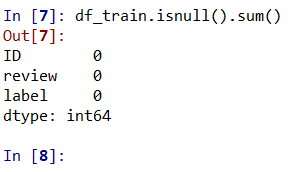开始继续完成大数据实验室招新题~
(roman urdu小语种为例)
link: https://www.kesci.com/home/competition/5c77ab9c1ce0af002b55af86/content/1
本练习赛所用数据,是名为「Roman Urdu DataSet」的公开数据集。
这些数据,均为文本数据。原始数据的文本,对应三类情感标签:Positive, Negative, Netural。
本练习赛,移除了标签为Netural的数据样例。因此,练习赛中,所有数据样例的标签为Positive和Negative。本练习赛的任务是「分类」。「分类目标」是用训练好的模型,对测试集中的文本情感进行预测,判断其情感为「Negative」或者「Positive」。
数据清洗
函数等相关内容转载自:https://blog.csdn.net/ssswill/article/details/88533623
这位大佬已经做的很完美,我仅仅只能是跟着他的步骤重新做了一遍,并记录下笔记。
当得到数据时,发现数据中存在很多的的符号,没法对数据进行直接分词处理。

并在此之前检查数据是否存在空缺
#test if nan exists
df_train.isnull().sum()

在此之后采用np.as_matrix()库将数据转换为矩阵形式
numpy_array = df_train.as_matrix()
numpy_array_test = df_test.as_matrix()
因此采用了常见的清理函数,对数据中的符号标点进行了清洗替换
本次主要使用的是re库的sub函数,也可以使用python基本库中的replace库。
re.sub(pattern, repl, string, count=0, flags=0)
参数:
pattern:表示正则表达式中的模式字符串;
repl:被替换的字符串(既可以是字符串,也可以是函数);
string:要被处理的,要被替换的字符串;
count:匹配的次数, 默认是全部替换
flags:具体用处不详
str.replace(old, new[, max])
参数:
old:将被替换的子字符串。
new: 新字符串,用于替换old子字符串。
max:可选字符串, 替换不超过 max 次
#nlp清理函数
def cleaner(word):
word = re.sub(r'\#\.', '', word)
word = re.sub(r'\n', '', word)
word = re.sub(r',', '', word)
word = re.sub(r'\-', ' ', word)
word = re.sub(r'\.', '', word)
word = re.sub(r'\\', ' ', word)
word = re.sub(r'\\x\.+', '', word)
word = re.sub(r'\d', '', word)
word = re.sub(r'^_.', '', word)
word = re.sub(r'_', ' ', word)
word = re.sub(r'^ ', '', word)
word = re.sub(r' $', '', word)
word = re.sub(r'\?', '', word)
return word.lower()
def hashing(word):
word = re.sub(r'ain$', r'ein', word)
word = re.sub(r'ai', r'ae', word)
word = re.sub(r'ay$', r'e', word)
word = re.sub(r'ey$', r'e', word)
word = re.sub(r'ie$', r'y', word)
word = re.sub(r'^es', r'is', word)
word = re.sub(r'a+', r'a', word)
word = re.sub(r'j+', r'j', word)
word = re.sub(r'd+', r'd', word)
word = re.sub(r'u', r'o', word)
word = re.sub(r'o+', r'o', word)
word = re.sub(r'ee+', r'i', word)
if not re.match(r'ar', word):
word = re.sub(r'ar', r'r', word)
word = re.sub(r'iy+', r'i', word)
word = re.sub(r'ih+', r'eh', word)
word = re.sub(r's+', r's', word)
if re.search(r'[rst]y', 'word') and word[-1] != 'y':
word = re.sub(r'y', r'i', word)
if re.search(r'[bcdefghijklmnopqrtuvwxyz]i', word):
word = re.sub(r'i$', r'y', word)
if re.search(r'[acefghijlmnoqrstuvwxyz]h', word):
word = re.sub(r'h', '', word)
word = re.sub(r'k', r'q', word)
return word
def array_cleaner(array):
# X = array
X = []
for sentence in array:
clean_sentence = ''
words = sentence.split(' ')
for word in words:
clean_sentence = clean_sentence +' '+ cleaner(word)
X.append(clean_sentence)
return X
X_test = numpy_array_test[:,1]
X_train = numpy_array[:, 1]
#Clean X here
X_train = array_cleaner(X_train)
X_test = array_cleaner(X_test)
y_train = numpy_array[:, 2]
处理后观察

发现数据已经被完全清洗。